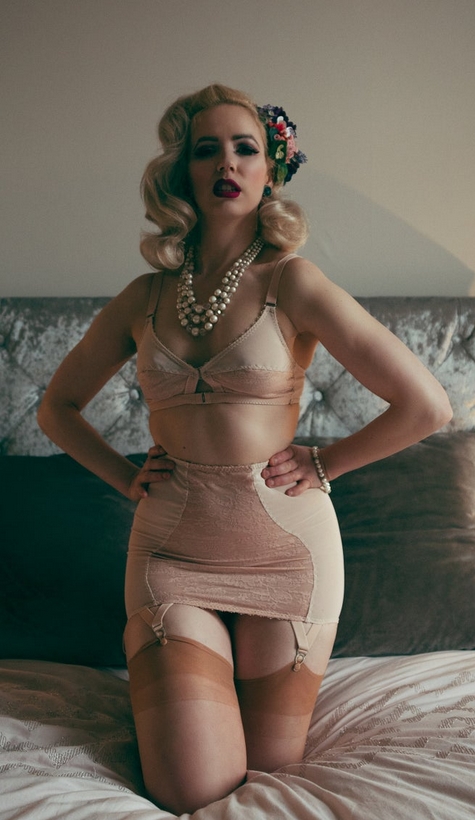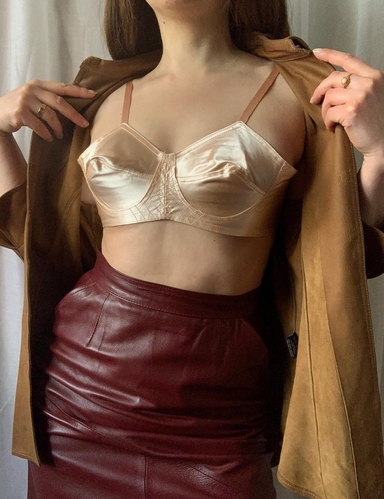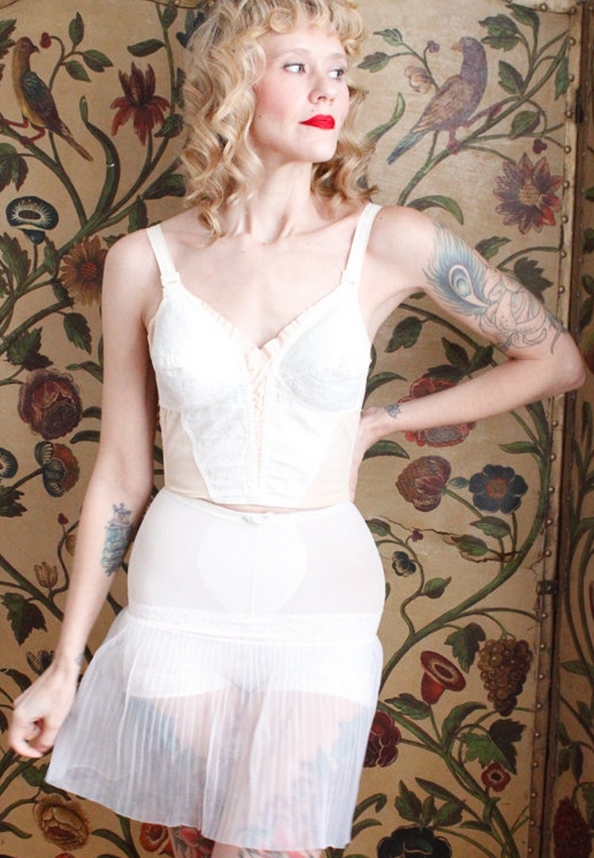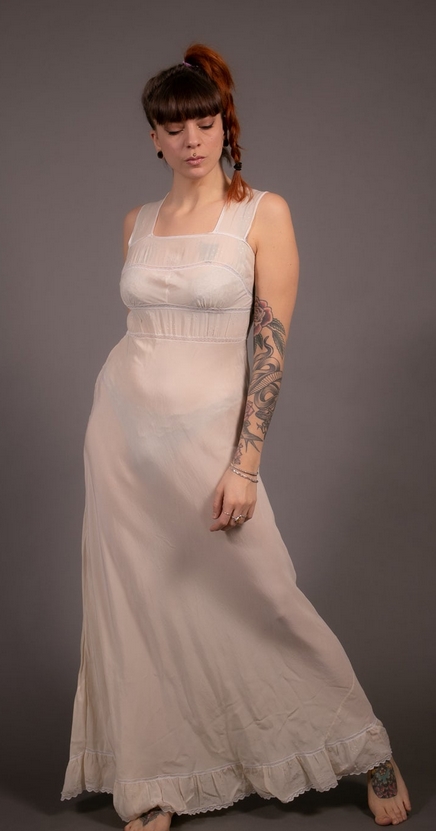Disclosure: This post may contain affiliate links. I receive a small commission at no cost to you when you make a purchase using my link.
1940s lingerie embodies expansion, diversity, utility, style, and comfort. Designed to serve a larger range of body types, compared to previous decades, and serve the wallets of women during an economically challenging period, 1940s lingerie styles and trends remain a modern-day icon.
Women in the ’40s were working while men were off at war. They didn’t spend a majority of their time lounging in restrictive undergarments. Instead, they enjoyed their freedom and independents. In style, no less. However, there was always a piece of lingerie for every occasion.
For daywear, you could expect a woman to wear a girdle and bra, longline bra and girdle, and all-in-one, or a strapless bra or strap bra and garter belt combo. For sports and recreation, cotton or rayon bandeau bra and pantie girdles that provide optimal flexibility and movement were preferred. And for evening wear or occasions–an all-in-one or corselette was strapless for youthful figures and with straps for fuller figures, was preferred. A low back cut-out was also designed for low back gowns that were popular in the mid-1940s.
Sizing was taken into account more than before, so there was something comfortable for differing body types. This also created a variety of possible silhouettes instead of striving for a single trend like the boxy boy shape of the 20s or the flattened tummy of the 30s.

VintageDancer helps us chart out the four body types and suggested 1940s lingerie.
Junior: Lightweight bandeau; pantie girdle with satin front panel; elasticized sides and back. Pull-on girdles are popular with teens. Girdles with boning on the back help train a girl to have correct posture. Favored colors were black, nude, yellow, and blue with pretty embroidery of flowers.
Misses: Bra with supporting band; closer-knit girdle with a waist-hugging band; elastic inset sides and back; side zipper closing. A misses’ body is still young and firm, needing little shaping. The ideal measurements of a young woman were height: 5’2″-5’3″, bust: 35.5 inches, waist:29 inches, and hips: 38 inches. These ideal numbers grew slightly as women aged.
Average: Brassiere with good separation, high-waisted elastic, and fabric girdle for maximum control. The bra may need thicker shoulder straps to provide appropriate lift and breast separation. Longline bras provide lift without the pressure of shoulder straps. An All-In-One is also ideal for the average body as it both shapes soft flesh and creates curves.
Full figure: Strong, heavy fabric, all-in-one garment controls curves. Boning lends extra support, Built-in brassiere molds chest and back flesh. Full figures need an All-In-One to achieve the 1940s silhouette. A version with long thigh coverage is critical to a smooth figure.
Here’s a closer look at the individual pieces.
1940’s Brassiere

The term Bra was officially coined in the forties, but that’s not the only thing to change about this essential piece of lingerie. Cups became more pointed instead of flattened and adjustable bra straps stemmed from the center of the cup for a lifted and separated look. Strapless also became available for summer dresses or gowns with a low back or neck, and an off-shoulder peasant blouse.
For a dramatic enhancement, the bullet bra was very pointed giving an unnaturally large and cone-shaped bust. The bra to garter setup was still in place for larger busts to be securely fastened. Embellishments, design, texture, and colors were added to bras, making them far more exciting and varying than ever before. A thinner fabric was used as an option for small busts. These were called a bandeau instead of a brassiere.
Bras in the ‘40s became much more full-coverage and “heavy duty”. An underbust band wrapped all the way around the bra and stretched several inches below the bust for support and to create separation between bust and waist and to smooth out any contours. Underwires did exist but unlike today where they create support and lift from the bottom, the underwire bras in the 1940s created a separation in the middle.
A longline bra had a built-in girdle that sinches the torso with boned paneling and was preferred by average to full-figured women. Ready-made bust pads were also introduced for smaller chests.
Underwear & Panties in the ’40s

The throwback granny panty came into full swing in the forties. High-waisted, loose-fitting, with an elastic band and made from silk–underwear in the 1940s looked more like sports shorts than bikini bottoms. Some even came down to the knees.
Some underwear had yoke with lacing. Fitted panties came out toward the end of the 1940s for tummy control and medium support.
1940’s Girdles, Garter Belts & Slips
Girdles were praised for their shaping ability and improvements to posture but they were designed to be more comfortable and functional than they were in the ’30s. They were made with a small amount of elastic to include a bit of stretch.
Garter belts were essential to holding up stalkings. In many cases, the girdle and garter were swapped for an all-in-one or step-in that combined the shaping ability and supportive functionality of bra, girdle, and garter into a single piece. The hourglass shape was favored thus the corselette was designed accordingly.

Slips were the last clothing layer a woman expected to make the ideal shape. The vast majority of ladies wore slips on top of their primary lingerie pieces and under a dress. Slips came in long dress-like assortments or petticoats for skirts, also called half-slips.
Slips were normally white, dark, or soft pink. Silk or rayon made the best slips while cotton weave was the most affordable slip. However, some slips were inclined to cluster at the knees and adhere to the dresses. Fabric slips held body heat and were not worn in a warm climate. Slips had flexible slim straps and figure-complimenting cuts. The slip top either arrived in a V-neck cut for a dress or a square neck cut for pullovers. No dress, suit, or skirt would be finished without a slip to hold garments back from sticking to the body.
1940s lingerie was worn in the following order:
- Brassiere
- Panties
- Stockings – put on before girdles and all-in-ones, but clip stockings into place afterward the girdle/garter
- Girdle, panty girdle, or All-In-One,
- Garter, if separate than above, then
- Slips and petticoats.
1940s lingerie was fun and functional and continues to be the inspiration of many pinup or modern-day lingerie looks.
Head over to Etsy for a browse vintage 1940s lingerie.




Leave a Reply